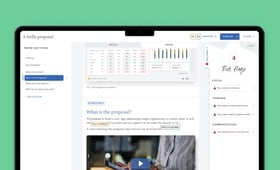Key takeaways:
To ensure board effectiveness:
- Track metrics across performance, composition, attendance, culture, and stakeholder feedback.
- Combine internal reviews, peer assessments, external evaluations, and digital tools.
- Use structured dashboards, visual summaries, and video explainers to boost engagement.
Why does board effectiveness measurement matter?
- Current gap: Board performance is lagging behind executive expectations. Only 30% of C-suite executives describe their board as good or excellent. That gap is a clear threat to strategic clarity and governance strength.
- Optimization: Measuring board effectiveness is essential for delivering good corporate governance and ensuring that boards add value. Organizations should regularly assess their board and committee performance to identify areas for improvement. Many corporate governance codes and best practice guidelines recommend periodic board effectiveness reviews to maintain high standards and hold boards to account.
What are the critical board effectiveness metrics and KPIs to track?
It’s important to think about board effectiveness in its broadest sense. That means going beyond measuring the three traditional pillars of board effectiveness (individuals, information, and infrastructure) and digging into other factors, like the board’s role in innovation and its decision-making agility.
How do you define success criteria and set performance benchmarks?
What does success look like for your board? This is the first question you must ask before measuring anything. To answer it, ensure your board has a focused and clearly defined mandate. Not only does this help with things like agenda planning and board reporting, but it also ensures that everyone knows why the board exists and what it needs to achieve.
You’ll need to define clear goals and track benchmarks, for example, how quickly your board makes decisions after identifying issues or how many strategic initiatives are completed on schedule. This creates accountability for board performance and helps identify when processes should be adjusted to improve effectiveness.
Essential board performance indicators
A KPI dashboard pulls together relevant metrics to provide a snapshot of the board’s performance against its agreed objectives. Track both numbers and feedback, including:
- Decision timelines.
- Attendance rates.
- Director engagement scores
- Stakeholder confidence levels.
These objectives may include speed and quality of decisions, attendance, board independence, director engagement, stakeholder confidence, and board evaluation scores.
With a well-structured KPI dashboard, you can filter through masses of data to find the most relevant points for your board to act on.
Board composition and independence metrics
Once you know what success looks like, you can collect and report on the relevant metrics. You can use a wide range of frameworks and tools to do that.
Take a scientific approach to analyzing board performance. This will deepen your understanding of the drivers of board effectiveness and open up new methodologies, tactics, and strategies. Monitor diversity metrics like gender balance, expertise mix, and independent director ratios to ensure that the board has the right combination of perspectives needed for strong oversight.
This “marginal gains” approach to building high-performing teams has proven successful in many other fields, from sports to trading, and will add significant value to boards.
Board assessment frameworks and methodologies
The board evaluation process should rigorously test whether the board's composition, operations, structure, and dynamics are effective, while taking the organization's unique context and strategy into account.
Internal vs external board evaluations
Internal reviews, though valuable, can sometimes follow a routine pattern and may be less objective or in-depth. Mix regular self-assessments with periodic external evaluations to get both candid insider perspectives and an objective analysis of your board’s dynamics.
Self-assessment and peer review methods
Let board members evaluate each other alongside self-assessments to build accountability and identify development needs. Peer reviews reveal how directors interact during discussions, contribute expertise, and support collective decision-making. Formal evaluations often miss these insights.
Digital tools for board assessment
Digital platforms make board assessment faster and more insightful than paper-based approaches. The right tools let you collect feedback quickly, spot trends across multiple assessment cycles, and visualize performance patterns. The real advantage comes from tracking whether improvement initiatives are working between review periods and catching declining performance before it becomes a serious problem.
Quantitative and qualitative board effectiveness measures
Qualitative measures focus on the “why” and “how” behind board behavior and outcomes, and add context and detail to our understanding of board performance. While these insights are powerful, they should not be used in isolation; we also need hard numbers to work with. That's where quantitative questions come in.
Board meeting analytics and attendance metrics
Attendance patterns tell you more than just who shows up; they reveal engagement levels and potential red flags about board dynamics. You should track attendance rates, meeting frequency, how actively directors engage during discussions, whether board materials get accessed promptly, and if preparation time translates into meaningful participation. When directors consistently access materials late or don't participate in discussions, it often signals deeper issues with meeting structure or director commitment.
Board culture and dynamics assessment
Gauge trust, engagement, and collaboration through surveys and direct observation during meetings. A healthy board culture drives both team effectiveness and company performance — research by the Board Intelligence Think Tank found that organizations with a healthy culture deliver 200% higher shareholder returns.
Corporate board dynamics can shape the success of an organizational transformation program. Studies show that board structures, diversity, and decision-making processes can facilitate or impede transformation initiatives.
Stakeholder satisfaction measurements
Survey executives and stakeholders on how well the board provides support, strategic insight, and timely responses to business challenges. These external perspectives can help bridge the gap between how boards think they're performing and how their support lands with the people who depend on their decisions. With this overview, boards can create more effective roadmaps for focused improvements.
Implementing board effectiveness measurement systems
Various measurement tools are available, and they are increasingly easy to implement. Boards can use online self-assessment tools, get real-time data from their board portal, or track the quality of their board papers in real time through tools like Lucia, Board Intelligence’s AI-powered board reporting platform.
Data collection strategies and review cycles
Automate data collection through digital forms and board portals, then schedule quarterly or annual review cycles to spot trends before they become problems. Regular assessments will help boards course correct, which is better than waiting for crisis-driven evaluations.
It’s considered best practice to conduct a survey-based board assessment once a year, and an external board evaluation once every three years. These evaluation processes should also include the board’s committees.
Action planning and performance improvement
You can convert metrics into targeted action plans by creating visual dashboards that highlight performance gaps and the steps needed for improvement. With the Chartered Governance Institute UK & Ireland, Board Intelligence has created two free tools to help organizations evaluate the quality and efficiency of their board reporting: a board reporting self-assessment tool and a Board Reporting Calculator.
Prioritize the issues and opportunities you want to focus on first. Ensure that actions are well defined and measurable, with clear owners. You can read our guidance on best practice performance reporting here.
Progress tracking and monitoring tools
Board meeting minutes record the outcomes of board discussions but don’t track the progress of board actions or delegations. Board packs should include an action tracker to record the progress of actions agreed upon, separating the outstanding from the in-hand and closed actions.
Track KPIs over time using charts and progress trackers that help boards spot patterns and respond to declining performance before it becomes critical. Visual trend analysis makes it easier to identify when interventions are needed and measure whether things are improving.
What are the best practices for continuous board improvement?
You can establish a culture of continuous improvement by regularly reviewing the methodologies, tools, and metrics you use to evaluate board effectiveness, and changing them, when required, to ensure they align with the organization’s needs.
Annual vs periodic board reviews
An improvement mindset starts with how often you evaluate performance. Combine annual assessments with mid-year pulse checks to maintain momentum between formal reviews. Short interim surveys can catch emerging issues or confirm that improvements from the previous assessment are working as intended.
AI and technology in board performance monitoring
Use AI tools to generate insights, detect red flags, and analyze the quality of board materials. Organizations already using AI for board processes report significant productivity improvements and better preparation quality compared to manual approaches.
Use our assessment tool to find out how effective your board reporting is and get actionable tips on how to improve the quality of your board pack.
Start nowFAQs
-
How often should boards conduct effectiveness reviews?
This depends on regulatory requirements, best practices, and the organisation's specific needs. Most organisations conduct a high-level performance review yearly. Assessments could be conducted more frequently during periods of significant change, such as mergers, leadership transitions, or regulatory updates.
-
What are the key metrics for measuring board performance?
Key metrics focus on operational efficiency and strategic impact. Common indicators include board composition and independence, board engagement and attendance, alignment with corporate strategy, and risk and compliance oversight. Other metrics include stakeholder satisfaction and financial oversight.
-
Should boards use internal or external evaluators to measure their effectiveness?
For UK-listed companies, using both internal and external evaluations aligns with best governance practices and regulatory requirements. Annual internal reviews ensure ongoing monitoring and regular calibration. External evaluations every two to three years provide an unbiased perspective and benchmarking, keeping in mind that high-risk industries such as finance and energy may benefit from more frequent external reviews.
Can't find what you're looking for? Our friendly team are on hand to help.
Talk to our team


